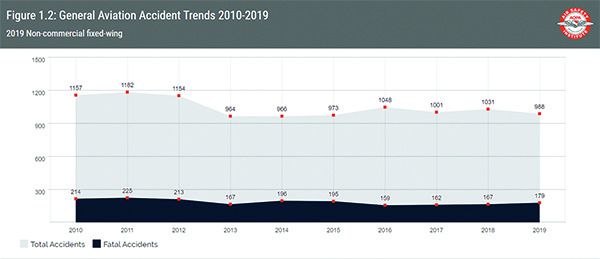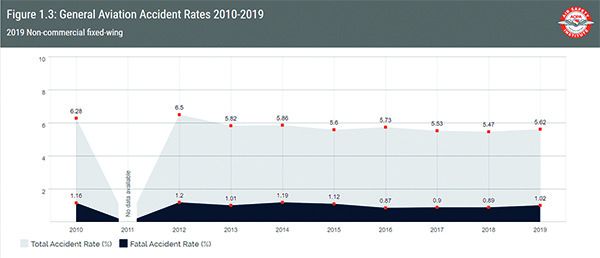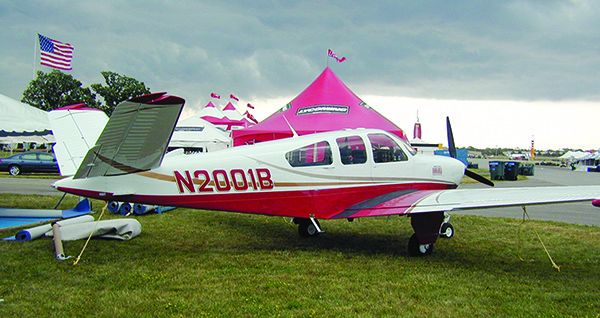The AOPA Air Safety Institute (AOPA/ASI) recently released the latest in its continuing series of Joseph T. Nall Reports, the 31st. As with last year’s release of two years’ worth of data, AOPA/ASI is publishing the latest report on its web site, which allows it to provide monthly updates as new numbers flow in. As the organization states, the new format presents “users with near real-time accident analysis updated on a rolling 30-day cycle.” By going all-electronic, data from 2008 to the most recent month is available in one place.
That’s the good news. The bad news, according to AOPA/ASI? “Fatal accident rates in non-commercial fixed-wing, commercial fixed-wing, and commercial helicopter all rose,” although non-commercial helicopter accident rates fell, which isn’t to be ignored. Breaking down the data into potential solutions, the AOPA/ASI said, “Stall/loss-of-control events continue to be the leading causal factor and weather-related accidents remain highly lethal. These accident causes relate to pilot decision-making and proficiency and this data helps inform the industry.” This development is despite a reduced total number of accidents, including fatal mishaps. In other words, we’re flying less and crashing more often.
Additional details from the newest Nall Report show there were 988 total accidents involving non-commercial fixed-wing aircraft, of which 179 were fatal, as shown in the graphic below. Even though the number of overall accidents was lower in 2019 than 2018, a decrease in hours flown by non-commercial airplanes over the year resulted in an increase in the accident rate, to 5.62 per 100,000 hours, shown in the graphic on the following page. There also was an uptick in the number of fatal accidents, resulting in the accident rate rising to 1.02 per 100,000 hours. According to AOPA/ASI, “The percentage of pilot-related accidents, again, fell below 70 percent.” However, AOPA/ASI warns, “this trend tends to shift as accident reports are completed.”
The 2019 AOPA/ASI Nall Report, along with those from earlier years, is available online at: tinyurl.com/SAF-2019Nall.


Bonanza Type Club Offers Real Money For New Ruddervator Skins
The classic Beechcraft Model 35 V-tail Bonanzas are unique airplanes. Except for things like airframe parachutes and extensive use of composite structures, they stack up well against more modern models, especially when it comes to speed and payload on the same power. But the last V-tail Bonanza left the factory in 1982, making the youngest of the product line 40 years old in a few months.
As the same basic model had been in production since 1947, as more than 10,000 were manufactured, and as there are 5204 V-tails on the U.S. registry in October 2021, according to ABS, a sizeable market for them remains, and most parts are still available. Except for its unique tail, that is: There are no more new ruddervator skins, anywhere. According to ABS, “Replacement ruddervator skins are no longer available from Textron Aviation [which] is apparently unwilling to design and certify an alternative solution….” In other words, if your V-tail suffers hangar rash and an RV can’t be repaired, you’re off to the junkyard for a used part, and good luck with that.
The lack of new ruddervator skins stems, at least in part, from the material required: a magnesium alloy. The ruddervator balancing tolerance is so tight that aluminum skins of the required strength can’t be used. It’s an obvious, existential problem for the fleet and one its type club—the American Bonanza Society, ABS—has been trying to resolve for years.
In 2019, the ABS Air Safety Foundation decided to up the ante in its search for new RV skins: offer cash money to whoever comes up with FAA approval to manufacture new ones. The organization offered “$100,000 to be awarded to the first firm to certify and produce an alternative to original ruddervator skins.” To date, no one has come up with the required alternative. Now, the foundation’s prize is being increased to more than $500,000.
According to ABS/ASF, “A single $500,000 prize will be awarded to the first firm or individual that designs and obtains FAA certification of an alternative to original ruddervator skins or a replacement for the entire ruddervator assembly, creates a production and manufacturing capability, and produces at least 100 FAA-approved kits ready for sale to the public,” along with other requirements described on the ABS web site.
“ABS members are being encouraged to match ABS/ASF’s commitment, potentially raising the total prize amount to as much as $1 million,” ABS says. As of October 25, 2021, it’s up to $511,000.




